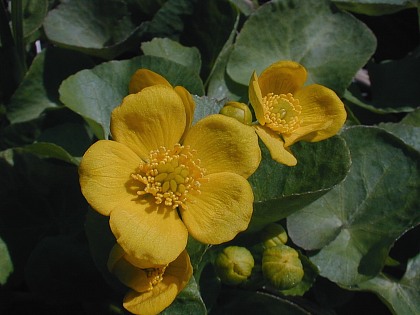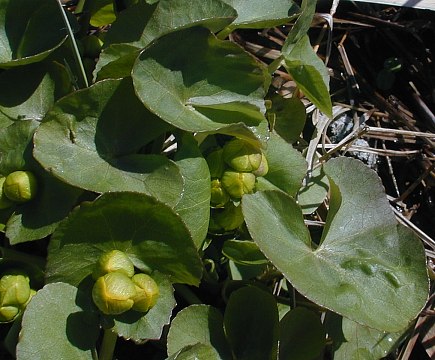Description: This perennial plant is about ½–2' tall; it branches regularly. The stems are hairless and hollow. Basal leaves are produced early in the year, while alternate leaves are produced along the stems. The blades of these leaves are up to 4" long and 4" across; they are orbicular-cordate, finely crenate along the margins, and glabrous. Their venation is palmate. The petioles of the basal leaves are up to 6" long, while the petioles of the alternate leaves are shorter than this. The upper stems produce small clusters of bright yellow flowers on short petioles. Each flower spans about ¾–1½" across; it consists of 5-9 petal-like sepals, a thick ring of abundant stamens, and a cluster of carpels in the center. There are no true petals. The sepals are bright yellow, well-rounded, and slightly overlapping. The blooming period occurs during mid-spring and lasts about a month. There is no noticeable floral scent. Each of the carpels matures into a seedpod that contains several seeds. This seedpod is flattened and recurved; it splits open along the upper side to release the seeds (technically, it is a follicle). The root system consists of a short crown with fibrous roots. This plant spreads by reseeding itself. It occasionally forms loose colonies at favorable sites.

Cultivation:
The
preference is full or partial sun, wet conditions, and mucky soil.
Shallow standing water is tolerated. Growth and development begin early
in the year.
Range & Habitat:
The native Marsh Marigold occurs primarily in central and northern
Illinois, where
it is occasional. In southern Illinois, it is uncommon or absent (see Distribution
Map). This circumboreal species also occurs in Eurasia, where
it is native as well. Habitats include various wetlands, including
vernal pools in low woodlands, swamps, soggy meadows in river
floodplains, marshes, fens, seeps and springs, and ditches. Marsh
Marigold prefers sunny areas where the soil is consistently wet from
underground seepage of water, although it occurs in other wetlands as
well.
Faunal Associations:
The nectar and pollen of the flowers attract flies and bees primarily.
This includes Bombylius major (Giant Bee Fly),
Syrphid flies, Halictid bees, honey bees, and others. Two leaf beetles
are occasionally found on the foliage of Marsh Marigold: Plateumaris
nitida and Hydrothassa vittata. It is
possible that they eat the foliage. For other herbivores, specific
information for Marsh Marigold is lacking. Because the acrid foliage
contains toxic alkaloids and glycosides, it is usually avoided by
mammalian herbivores. The seeds of plants in the closely related Ranunculus
genus are eaten by the Wood Duck, Sora Rail, and some upland gamebirds.
The seeds of such plants are also eaten by the Meadow Vole, Eastern
Chipmunk, and other small rodents.

Photographic
Location:
Near the Collinson Marsh in Vermilion County. Several colonies of
Marsh Marigold were growing in a ditch along a field where there was
underground seepage of water from a neighboring bluff.
Comments:
In sunny wetlands, Marsh Marigold is one of the first wildflowers to
bloom during the spring. The flowers are showy and conspicuous because
of their bright color and relatively large size. The foliage is an
attractive bright green. This species is not a true marigold of the
Aster family, in spite of its common name. Instead, it is closely
related to the many Ranunculus spp. (Buttercups)
that occur within the state. The various species of Buttercups have
smaller flowers (less than ¾" across) and they usually bloom later in
the year.